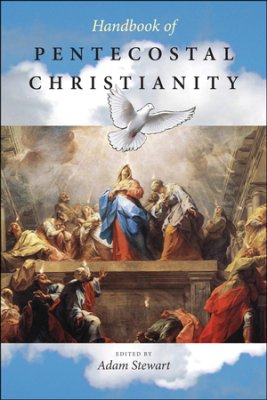Handbook of Pentecostal Christianity, reviewed by Wolfgang Vondey
 Adam Stewart, ed., Handbook of Pentecostal Christianity (De Kalb, IL: Northern Illinois University Press, 2012), 240 pages, ISBN 9780875806723.
Adam Stewart, ed., Handbook of Pentecostal Christianity (De Kalb, IL: Northern Illinois University Press, 2012), 240 pages, ISBN 9780875806723.
A handbook of Pentecostal Christianity is an important addition to the growth of recent literature introducing Pentecostal beliefs and practices. Twenty-four scholars provide concise essays on fifty topics in a format of a Reader or Introduction suitable for a general audience and students of religion (and Pentecostalism). Stewart has assembled an illustrious group of well-known scholars on Pentecostalism with strong and concise essays on topics matching their subject expertise. The result is an engaging explanation of various phenomena characterizing the global Pentecostal movement, from standard entries, including the Azusa Street mission and revival, the baptism in the Holy Spirit, the full gospel, exorcism, prophecy, and divine healing, to theological topics, including ecclesiology, eschatology, and dispensationalism, to important figures, such as William J. Seymour, William Howard Durham, and Aimee Semple McPherson, this handbook is a “handy” resource when more exhaustive dictionaries and encyclopedias of Pentecostalism are not available.
The book serves two objectives: (1) to assist college, university, and seminary students interested in Pentecostalism, and (2) to serve the general reader as a concise resource. Although the book resembles a reference-style dictionary, it is not intended as an exhaustive resource but rather as a collection of concise entry-points by Pentecostal scholars to the history, theology, practices, and contemporary forms of Pentecostalism. A brief introduction precedes the essays and highlights the purpose of the book, the selection of entries, and perspectives of the authors, and concludes with a sample course outline for using the book in the classroom. At Stewart’s own admission, the entries of the book are heavily weighted toward North American classical Pentecostalism. The essays are written from what could be considered a broadly critical perspective, with the intention to provide ten lead essays from a largely normative perspective (which appears identical with the classical Pentecostal perspective): Acts of the Apostles, Baptism of the Holy Spirit, exorcism, healing, hermeneutics, Holy Spirit, initial evidence, salvation, spiritual gifts, and suffering. The main objective is undoubtedly to cover topics of Pentecostal Christianity that most (classical) Pentecostals would consider essential.

Adam Stewart
The choice of topics is certainly debatable, and disagreement might be expected. Nonetheless, the fifty topics selected are a sound basis for this introductory text. Perhaps more significant is the identification of normative essays anchoring the selection on particular doctrinal themes. A different option would be to identify several key contextual essays on the global nature of Pentecostalism: African Pentecostalism, Asian Pentecostalism, Australian Pentecostalism, European Pentecostalism, Latin American Pentecostalism, Native American Pentecostalism, North American Pentecostalism, and Oneness Pentecostalism. In contrast, the identification of Pentecostalism as an “American” religion (4) is unfortunately counterproductive to the purposes of the book, to many of the topics, and several authors included in the collection. The proposed course outline reflects this choice in a manner that should essentially be reversed: two segments on global Pentecostalism are sandwiched between historical, practical, and doctrinal explanations that portray Pentecostals as a revival movement which has migrated from North America. Awareness of origins, institutions, and developments outside of North America (and predating the American revivals) can be found in the essays but is not widely represented. The fact that the ten normative essays are written by only three scholars from the global North adds to the challenges to portray Pentecostalism as a global Christian phenomenon. These features are not likely readily apparent to the general reader or beginning student of religion and unfortunately perpetuate the idea that Pentecostalism is an American product. When this limitation is understood, the book should serve well readers in the North American market. For a global perspective, however, other supplementary texts should be consulted.
Category: Church History, Fall 2015


